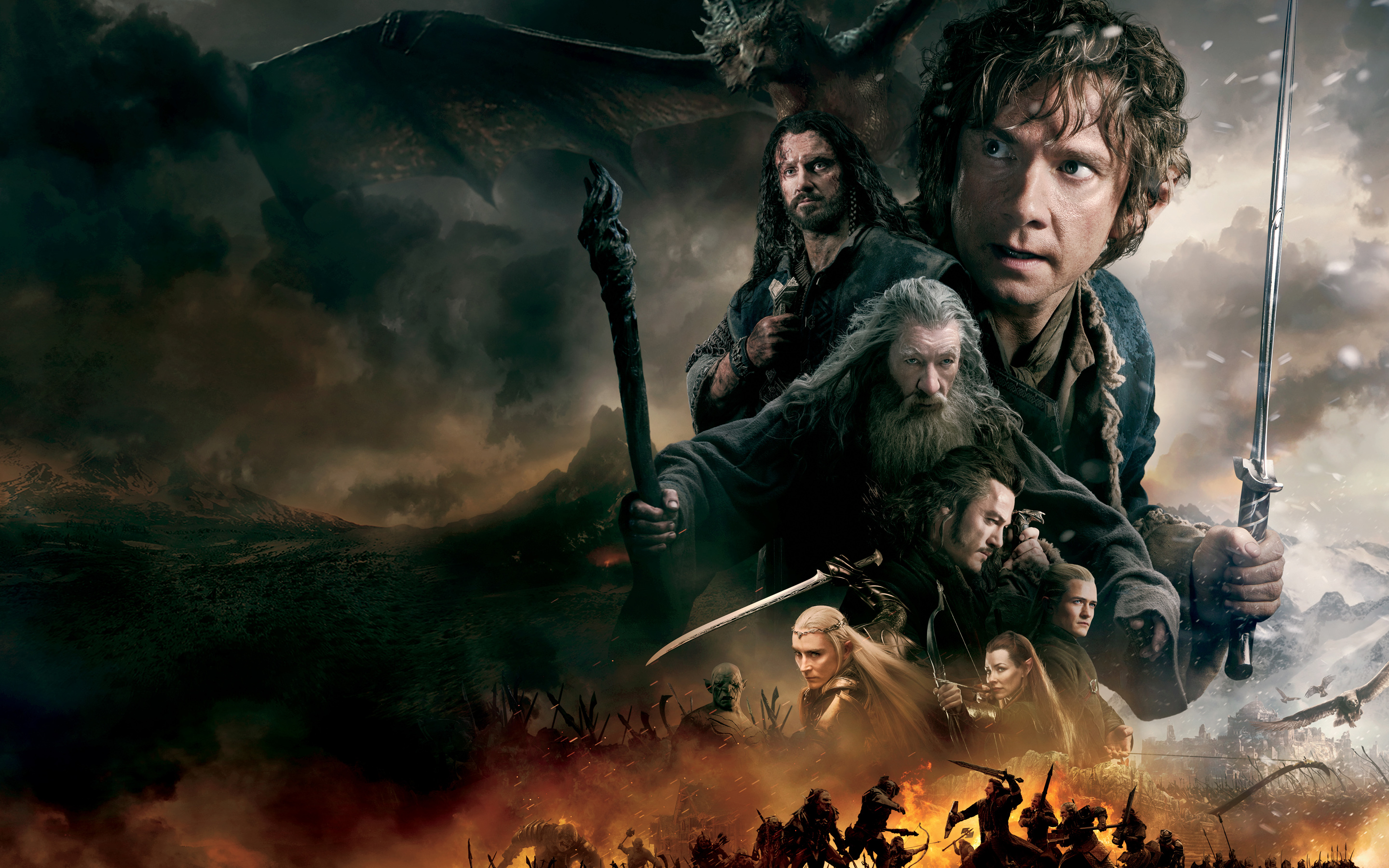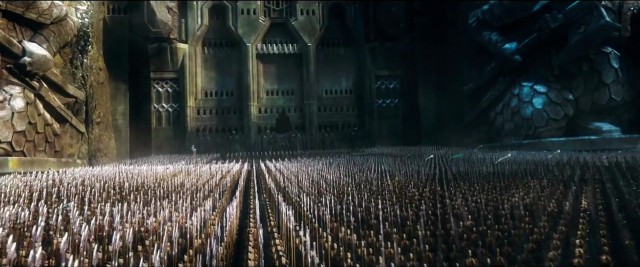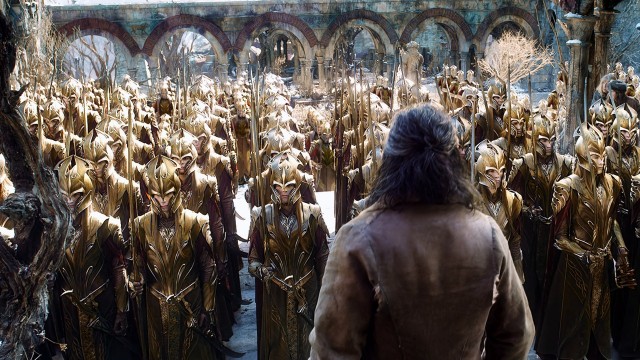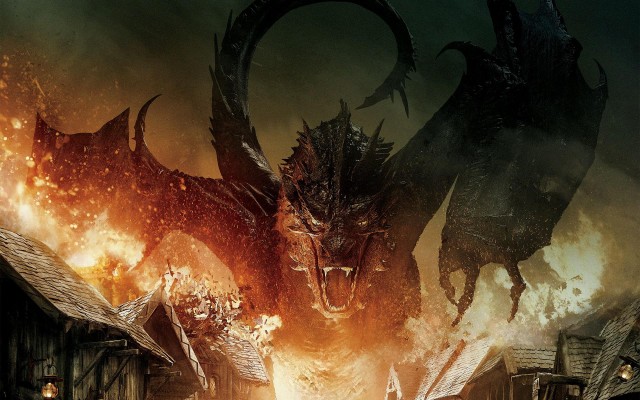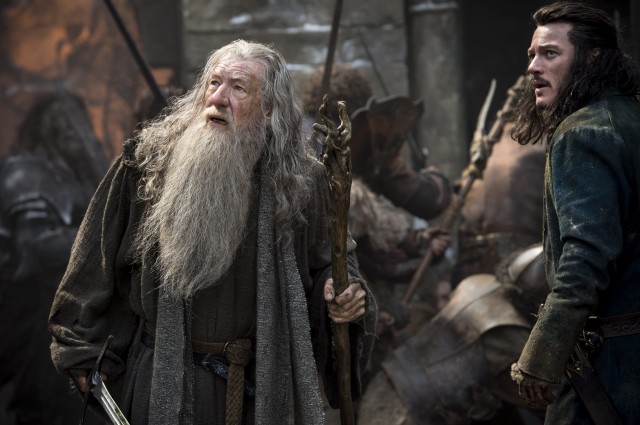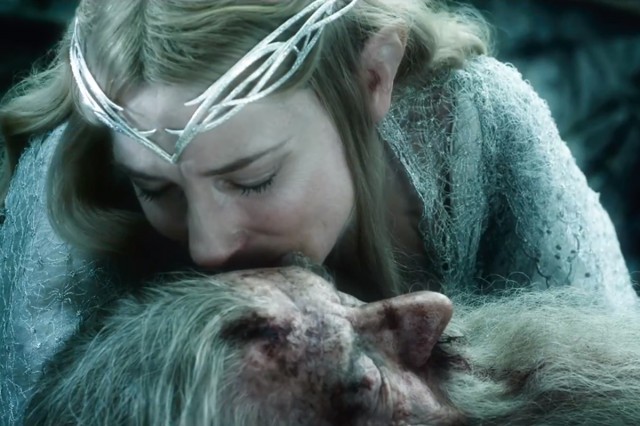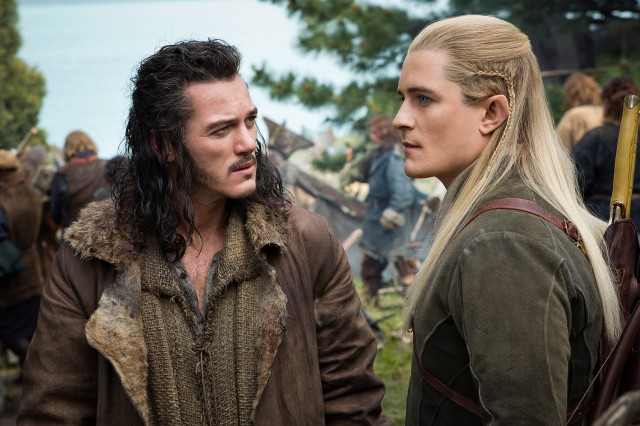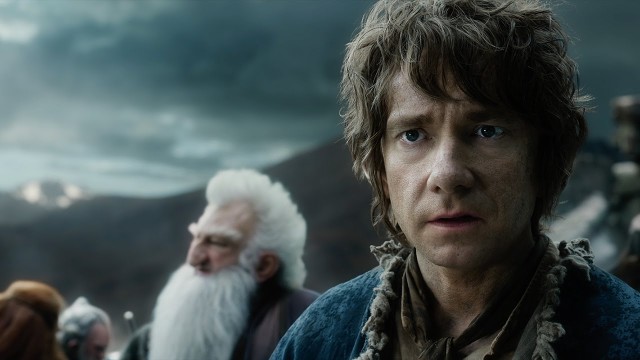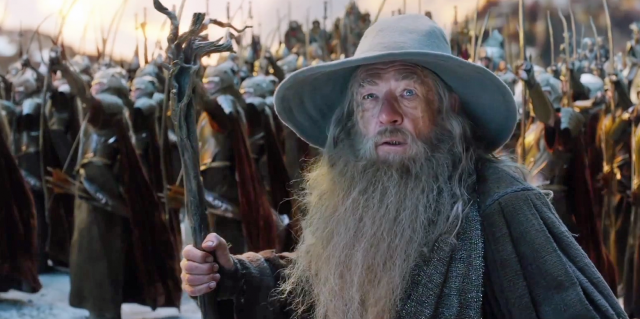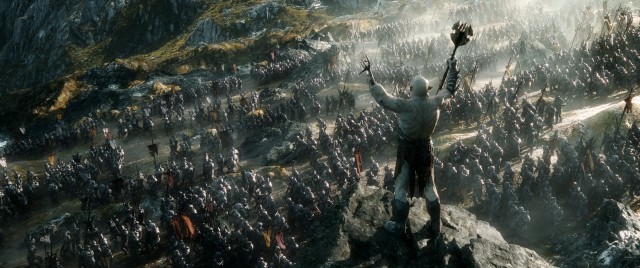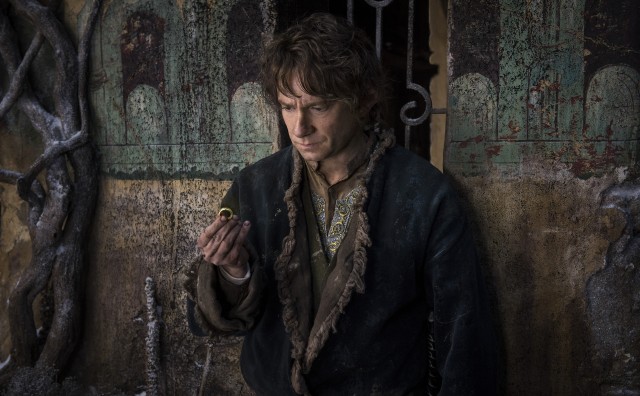“This was the last move in a master plan!” Gandalf declares at one point during the conclusion of the Hobbit trilogy. It echoes the state of the trilogy itself, with the revised three-movie structure all leading into the big fight that many knew to expect from the climax of the Hobbit novel, The Battle of the Five Armies.
The title was changed from the original The Hobbit: There and Back Again, which is fitting here, as the big battle is really all that this concluding movie is about. Even being the shortest of Peter Jackson’s six cinematic forays into Middle-earth, being only about two-and-a-half hours long, The Hobbit: The Battle of the Five Armies just feels like a necessary finale, rather than an organic one. It’s still quite good, but it lacks the more exciting and well-produced appeal of last year’s middle chapter, The Hobbit: The Desolation of Smaug, and suffers from a disjointed structure, as well an expected lack of material left over to mine from what is otherwise just a single, shorter novel.
If you’ve enjoyed the previous Hobbit movies, then The Hobbit: The Battle of the Five Armies is the fitting end that we all knew was coming, and is still well worth experiencing. As a closing chapter to our time in Peter Jackson’s Middle-earth however, it bears the fatigue of stretching The Hobbit into three epic movies most blatantly of all, and makes for a bit of a weak finale, though still not a bad one by any means.
The Hobbit: The Battle of the Five Armies once again seems to sideline Bilbo in his own trilogy, making the movie more about dwarf leader, Thorin than anyone else. Bilbo has a key arc in the novel during the titular battle, where he commits a massive act of what seems like outward betrayal, but the arc is thinned out and hits with an emotional thud for most of the movie.
The exception for his character’s continued lack of dramatic impact in a trilogy that’s supposed to be about him is when Bilbo inevitably returns to The Shire, which is when the emotional weight of his quest finally becomes apparent. The novel still explored it better, but the movie at least does a solid job of making Bilbo feel that he gained something from his adventure, equal parts uplifting and tragic. For what it’s worth, he at least has more to do here than he did throughout most of The Hobbit: The Desolation of Smaug, but just a bit. Strangely, it feels like only the first movie, The Hobbit: An Unexpected Journey, was truly about Bilbo in the end.
Fortunately, the material with Thorin is realized far better. During the time of this third movie, Thorin has succeeded in his quest and reclaimed both The Lonely Mountain and Erebor, though the Arkenstone, the proof of kingship, still eludes him. Developing, “Dragon sickness”, the movie’s explanation for why Thorin has done such a radical one-eighty here, Thorin sinks further into greed and obsession, threatening his own subjects, and refusing the claim of Smaug’s treasure that he promised to Laketown, with the wood elves of Thranduil also believing they have claim to some of the treasure.
The exploration of Thorin and what his quest has led up to is where The Hobbit: The Battle of the Five Armies achieves any real drama and weight behind a movie that is mostly just a lot of fighting and death. Richard Armitage steals the show as Thorin here, being the character that feels more like he’s on a real journey than Bilbo is at this point. Armitage takes Thorin from being a king to being a menace to being a psychopath to being a tormented soul, and finally, to being the answer of what Bilbo’s journey is about. It’s a laboured character arc in terms of getting back to Bilbo, who is supposed to be the protagonist of this trilogy, but the arc of Thorin himself is sublime here, and a key strength of this finale.
Unfortunately, many of the other characters throughout the movie get the shaft, despite the interesting developments that The Hobbit: The Desolation of Smaug in particular led up to. Gandalf inevitably escapes his captivity from Dol Guldur, resulting in a very cool, action-packed sequence that sees Cate Blanchett return as Galadriel, and brings a couple of other Lord of the Rings cameos in tow, namely Christopher Lee reprising his role as Saruman the White, and Hugo Weaving reprising his role as Rivendell elf leader, Elrond. Don’t get too excited though, as these characters literally walk on and walk off the movie, simply being some neat fan service that serves as a way to get Gandalf back to his company, while teasing the best events to come in the Lord of the Rings trilogy that is already complete and available. Still, at least they offer one of the movie’s more appealing scenes, especially since Gandalf is never used for anything in this movie beyond being an exposition dump, again.
Similarly, Lord of the Rings hero, Legolas, who again shows up in this third movie, despite not being present in the source novel, is left to do nothing but fight orcs. This loses some impact as well, since we know that Legolas will survive, and obviously won’t rejoin the wood elves, so that he can be a protagonist in the Lord of the Rings trilogy. His reasoning for everything feels contrived, especially since original elf character, Tauriel, whom Legolas is supposed to be in love with, similarly isn’t given much to do but fight.
Luke Evans is at least given some better material as Bard, who is a more noble and strong character now, as his people turn to him in the wake of Smaug’s scourge on Laketown. Bard being more leader-like is a great switch that makes him one of the movie’s better heroes, particularly when he’s one of the only parties not seeking a fight with Thorin. It makes you wonder why such a great personality wasn’t present during the events of the Lord of the Rings trilogy though. In fact, that plot hole is raised with a few other surviving characters as well, which is an inevitable trap that big franchise prequels tend to fall into.
Azog is supposed to be the movie’s villain, returning to exact his revenge on the dwarves that maimed him before, but he’s less a villain and more a plot device. He simply generates the necessary army of orcs, worms and bats to start the battle that audiences are paying to see, and to serve as a final obstacle for Thorin. Ultimately, Azog feels like small potatoes compared to Sauron or Smaug, and that diminishes his impact as a villain, since you know that he’s barely a threat compared to those more powerful forces. Worse still is that Smaug is brought down in the movie’s prologue (this isn’t a spoiler, as even the trailers gave it away), and barely feels like he had any time to be a real danger to Middle-earth, even if this does line up with the events of the source novel.
There’s such a huge number of characters and personalities at play in The Hobbit: The Battle of the Five Armies that most of them are just lost in the shuffle of battle. Various characters appear and disappear just as quickly, to make their final bow before our time in Middle-earth is done with this movie’s conclusion. Few of them are given real time to shine beyond the fighting though, making it feel like most of their best character moments are either in the Lord of the Rings trilogy and haven’t happened yet, or were already realized in one of the prior two Hobbit movies.
That’s a fine proposition to a point, as The Hobbit: The Battle of the Five Armies is not wanting for massive battle sequences, even if they still don’t quite compare to the even larger warfare of the Lord of the Rings trilogy. It might have been nice if the actual dramatic stakes weren’t just contained to one or two characters though.
The Hobbit: The Battle of the Five Armies certainly isn’t guilty of false advertising with its revised title, but the structure of the movie’s story feels a bit suspect at times.
The movie begins immediately after the cliffhanger ending of The Hobbit: The Desolation of Smaug, with Bilbo exclaiming aloud, “What have we done?” as Smaug breaks out of the Lonely Mountain, roused by the dwarves, and preparing to incinerate Laketown with his fiery wrath. With the dragon laying waste to the town and Thorin’s company left to helplessly watch, Bard is left to undertake a desperate play, futily firing arrows that pitifully bounce off the dragon’s hide. It actually looks like there is no stopping the dragon as everyone perishes in the fire, with Smaug taunting Bard directly as he prepares to kill the bowman, until Bard fires the mighty black ballista arrow into Smaug’s lone weak point on his chest, finally killing the beast, and ending the massacre. Truth be told, it’s an outstanding intro that beautifully carries over from the second movie… And that’s the only problem with it. It doesn’t feel like the start of the third movie. It feels like the end of the second one.
Unfortunately, the highlight sequence with Smaug, easily the best in the movie despite the huge battle its title advertises, is over immediately, and the movie wastes its best moment in the prologue. Things properly get underway in the aftermath of Smaug’s death, which feels like a necessary wrap-up that nonetheless tries to distract audiences with plenty of battle sequences. Again, they’re good battle sequences, but that’s almost all that The Hobbit: The Battle of the Five Armies has to offer, especially past its first act, which feels dull, since it’s a lot of politics that feel like they carry no weight, particularly with the rise of Sauron being imminent.
The movie presents the idea of an interesting conflict, having Laketown and the wood elves suddenly turn on Thorin, who has shed his outward heroism after being consumed by greed and obsession, and leaving the door open for interpretation as to who exactly is in the right. That would have made for a very shocking and impactful finale in a better-paced movie, especially when Thorin calls in his even less reasonable cousin, Dain (played in a highlight part by Billy Connolly) but alas, the orcs soon ride in with their fell beasts, and once again, everything becomes neatly black-and-white, as everyone has to unite and defend against the objective evil of the shadow, squandering that opportunity.
It still makes for plenty of cool battle sequences, which present sporadic scenes of colourful goofiness, reminding you that this is supposed to take place in the more vibrant and upbeat Hobbit trilogy. With the tone moving closer to the bleakness of the Lord of the Rings trilogy in this finale though, everything just comes off as feeling like a lesser version of the big battles in the Lord of the Rings trilogy, albeit with less annoying fake-out endings than The Lord of the Rings: The Return of the King.
With two full acts of fighting before the denouement that brings Bilbo back to The Shire, battle fatigue will eventually set in for the audience (especially if you’re watching the high framerate cut!), who will no doubt wonder why the finale doesn’t have more substance beyond an overload of warfare. It may make for a spectacular goodbye to Middle-earth, but considering the dramatic highs achieved by The Lord of the Rings: The Return of the King especially, The Hobbit: The Battle of the Five Armies disappointingly feels overblown for a story that ultimately amounts to being surprisingly shallow.
Peter Jackson continues to realize extraordinary battles with The Hobbit: The Battle of the Five Armies, which feels grand in scope, without feeling too scattered or disorienting. Despite the crowded and chaotic fight sequences, Jackson’s control of the camera remains sublime, giving us all of the perfect views of the action, regardless of whether the battle is a pivotal duel, or just a cool display of taking on hordes of enemies.
Even considering some of the movie’s flaws, Jackson has put together The Hobbit: The Battle of the Five Armies with the same outstanding polish that he can be trusted to deliver. It may be wanting for actual fulfilling depth, but every moment has at least been put together with excellent quality, even outside of the fighting. A particular standout, as I mentioned, is the very beginning with Smaug decimating Laketown, which is one of the year’s most impressive displays of cinematography, visual effects and camera work by a director.
Some of the fun whimsy from the prior two movies may have been lost in The Hobbit: The Battle of the Five Armies, but the world of Middle-earth itself still feels beautifully realized, immersing audiences effortlessly when the story and the battle sometimes fail to do so.
Again, the whimsy from the score is pretty well gone by the events of The Hobbit: The Battle of the Five Armies, which is starting to meld with the composition style of the music in the Lord of the Rings trilogy. That’s certainly not a bad thing however, particularly not with Hobbit and Lord of the Rings composer, Howard Shore returning to do the music, as the Lord of the Rings movies have some of the best soundtracks in film history, and The Hobbit: The Battle of the Five Armies trying to meld together the two trilogies’ style of audio, even if it is skewing more towards the grand war horns of the Lord of the Rings trilogy at this point, is a sound idea that audiophiles should find both nostalgic and appealing on its own merits.
Naturally, the sound work in the battle itself is also very gripping and immersive, especially in the IMAX 3D cut. The battles don’t totally hit with the violent impact that they do in the Lord of the Rings movies, but they certainly feel more vicious than they did in the prior two Hobbit movies, gradually giving the prequel trilogy more of an edge than it had before, as the lead-in to the Lord of the Rings movies. Every crash, swing and charge is still felt in the theatre very nicely, and it still helps to convey the rising stakes that are merely the calm before the storm as Sauron’s forces come together.
The Hobbit: The Battle of the Five Armies comes with enormous visual polish, as with the previous five movies set in Middle-earth. Middle-earth itself remains a gorgeous landscape, so far continuing to be untainted by the dark campaign of Sauron and the orcs, and while the tone of the movie is becoming darker, the titular battle still has at least a slight air of majesty and gloss that is only present in the Hobbit trilogy.
Again, the grand scope of the movie’s battle is incredible, as is the fantastic intro with Smaug, who remains an incredible realization of visual splendour, which makes his limited screentime hurt all the more. They both number among the most ambitious and well-realized visual beats in any movie throughout 2014, having the source novel continue to leap off of the page, and effortlessly onto the big screen. Even during the movie’s weakest moments, it never ceases to be a treat for the eyes, which helps to offset some of the battle fatigue that audiences will no doubt experience during the drawn-out fighting that comprises most of the movie.
As usual, I saw the movie in 3D, and was a bit disappointed to see that the 3D has become spottier in The Hobbit: The Battle of the Five Armies, feeling more like the weaker 3D job in The Hobbit: An Unexpected Journey. Considering how much The Hobbit: The Desolation of Smaug improved the 3D presentation in several key respects, this is the one part of the visual package in The Hobbit: The Battle of the Five Armies which feels slapdash and poorly-realized. There are some great 3D money shots here and there, still making the movie worth experiencing for people who enjoy 3D movies, and the IMAX 3D cut does at least add a tad more immersion to the 3D effect, though is largely not worth it if you could care less about the bigger screen and more potent sound. Frankly though, if you’d rather just watch The Hobbit: The Battle of the Five Armies in 2D, you’re really not missing much. Same goes with the high framerate cut, which will probably exhaust most audiences by making the extended battling feel all the more mentally relentless.
Still, realizing an endeavour on this scale is commendable in its own right, especially when the movie itself is so visually arresting overall. It may not quite reach the unprecedented scale of the Lord of the Rings movies, which still feel noticeably grander and more ambitious in scope, but The Hobbit: The Battle of the Five Armies still feels like a huge and beautiful experience, even if it sheds some of the scale of its predecessors.
The Hobbit: The Battle of the Five Armies is a good finale for Middle-earth and The Hobbit, but it feels like it could have been more. The movie feels like the biggest victim of one novel being split into three massive movies, like I said, and there’s just not much left to sustain a third and final chapter for the Hobbit trilogy, and for the cinematic saga of Middle-earth as a whole. On its own merits, it’s a tad disappointing, even if it’s a solid lead-in to the Lord of the Rings trilogy, while still failing to match its outstanding three offerings.
Fans of the prior two movies, and of Jackson’s Middle-earth saga as a whole, can see and enjoy The Hobbit: The Battle of the Five Armies with absolutely no reservations, even if they may be left wanting in some key respects. Despite its thin storyline and diluted character arcs, it’s still plenty impressive in terms of the direction, soundtrack and visuals. If you never took to Middle-earth before, you inevitably won’t in this finale, and if you didn’t have a high opinion of the prior two Hobbit movies, this final chapter won’t convert you.
If you prefer your climaxes to be grand and action-packed though, then The Hobbit: The Battle of the Five Armies delivers. It just doesn’t deliver a whole lot more than that, especially considering that this is our farewell to Jackson’s Middle-earth.

